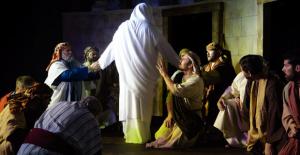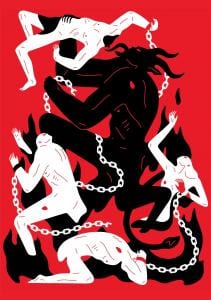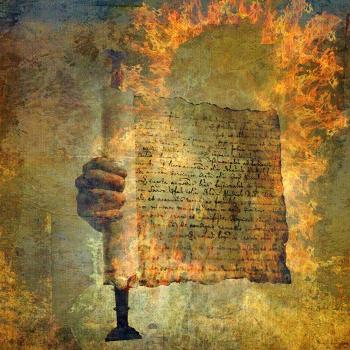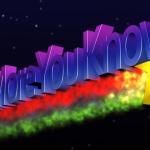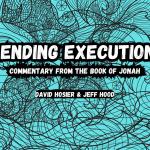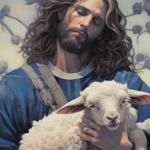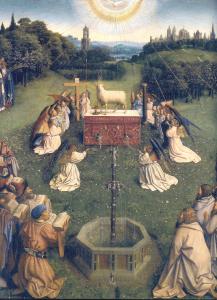
The book of Revelation is full of oxymorons. “The wrath of the Lamb” is an oxymoron (6:16). Lambs don’t have wrath. These images conceptually clash. “The wine of the wrath of God” is an oxymoron (14:10). Wine is a symbol of celebration, not wrath. The “Lake of Fire” (Revelation 19:20). How can water and fire occupy the same space? Again, these images simply do not blend.
Let’s consider some other oxymoronic imagery which pervades Revelation. Jesus is initially called the Lion of Judah in Revelation 5, but for the rest of the book is always referred to as “the Lamb”— hardly the picture of a wrathful killer. Jesus is pictured with “a sword coming out of His mouth” in 19:15, an “image-clash” between “speaking words of truth” and “hacking enemies to death.” In this same passage, Jesus is “treading” grapes in a winepress to make “the wine of the fierceness of His wrath.” But again, wine is a symbol of celebration and joy, not of anger and wrath. These images clearly contradict each other, and so should give us pause when we seek to interpret them.
Violent images continually converge with non-violent images. “The wrath of the Lamb,” (6:16) and “the wine of the wrath of God” (14:10) and “the winepress of the wrath of God” (9:15) and “the marriage supper of the Lamb… where ye eat the flesh of kings, captains and mighty men” (19:9) are all so contradictory. A lamb as an image of wrath? Wine, normally a symbol of joy and celebration, used as a symbol of wrath? A celebratory marriage feast where we eat the flesh of sinners? Jesus is portrayed as wearing a robe dipped in blood (19:13), but the blood is not His enemies but His own. How can a lake (Revelation 19:20), defined as a body of water, consist solely of fire?
Oxymoronic images abound all through the book of Revelation.
What is going on here? Often, when oxymorons are profusely used as they are here, it is often because the author’s intent is for us to totally deconstruct our presuppositions. By crashing these contradictory images into each other, the better truth then survives and arises victorious.
It is a battle of imagery where instruments of peace overcome brutal instruments of war. Swords are conceptually hammered into plough-shares. Instruments of wrath become attached to symbols of joy and celebration instead. God overcomes evil one way and one way only, with goodness. This is not theology but poetry. We need to see it as such and keep focused on the end of the matter: tears done away with, death done away with, pain done away with, Hell emptied, a new heaven and a new earth.
Applying this same oxymoronic dynamic to the concept of violence, we discover the following. We are to flood our enemies with forgiveness. We throttle them with tenderness. We overcome them with an opposite spirit. We resist them with non-retaliation. We maul them with meekness. We capture them with the love of God. We ambush them with the awe of the Lord. We bombard them with bounteous blessings.
Here then is the bombastic bottom line: Jesus Christ is the revealed wrath of God.
Or perhaps, more accurately put, Jesus is the revealed absence of the wrath of God against earthly humanity.
His attitude toward wrath (or its absence) was first declared when the Angels heralded His Father’s attitude toward us as, “Peace on earth, goodwill toward humanity!” Luke 2:14.
This attitude toward wrath (or non-wrath) continued during His incarnation when Jesus declared that both He and His Father “judge no man” during this earth age. John 5:22; 8:15. “And if any man hear my words, and believe not, I judge him not: for I came not to judge the world, but to save the world.” John 12:47.
Penultimately, He reaffirmed His attitude toward wrath with His dying declaration on the cross, “Father, forgive them for they know not what they do.” Luke 23:34.
Finally, “the wrath of Jesus” is described in the Book of Revelation by the oxymoronic term, “the wrath of the Lamb.” This phrase is oxymoronic because Lambs don’t have wrath, at least in any sense with which we are familiar.
Thus, the Lamb imagery subverts all traditional notions of wrath. If Jesus is indeed the revealed wrath of God, then God’s wrath is tender, restorative, and curative– like a lamb. It is NOT vicious, vengeful, and violent– like a predatory beast.
God destroys wicked notions, not wicked nations, evil purposes, not evil people. Listen to what “the wrath of the Lamb” produces at the end of the ages and for ever and ever. It’s not a battlefield of corpses but a united field of human and angelic awe at the goodness of God.
“And every creature which is in heaven, and on the earth, and under the earth, and such as are in the sea, and all that are in them, heard I saying, Blessing, and honour, and glory, and power, be unto him that sitteth upon the throne, and unto the Lamb for ever and ever.” Revelation 5:13.







